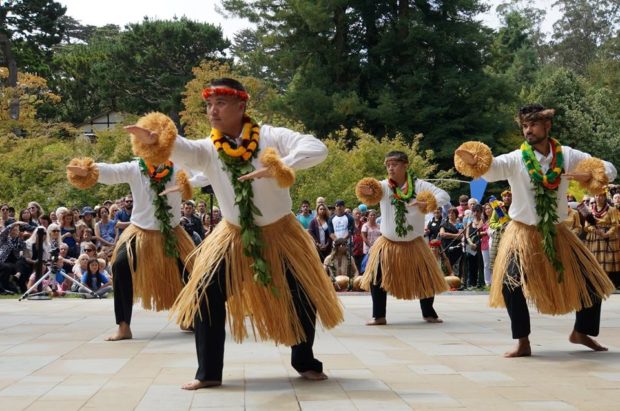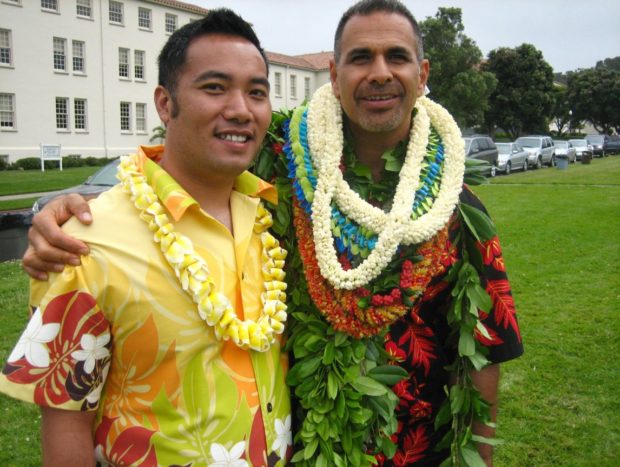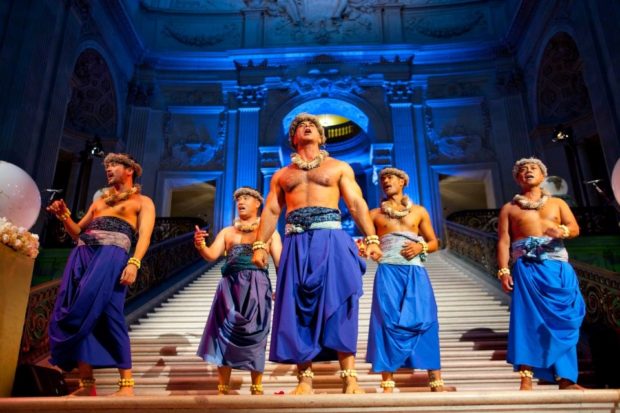Men who love Hula dancing

Na Lei Hulu I Ko Wekiu dancers in action. CONTRIBUTED
SAN FRANCISCO — Not all Hula dancers look like the girl with a lei and grass skirt bobbing on your dash board. In fact, there are also sculpted dude Hula dancers.
No, not the man in a barrel dangling something else.
Most people only know the come-hither hand expressions and the swaying of the girl’s grass skirt, promising but not really revealing.
Don’t try peeking at a dude Hula dancer. He may be a lua expert, skilled in the Hawaiian martial art that’s notably bone-crushing and said to be more brutal than jiu-jitsu.
It’s not an easy-to-find martial art. But if you look at even how a female Hula dancer begins, you will observe the crouched horse stance that’s also a basic ready position in Kung-fu (also like the horsey stance in Gangnam style). The beginning stance enables a practitioner to gather his energy.
Neil Romabiles was mesmerized when he saw a performance with a chanter accompanied by ipu heke (gourd drum). “The nearly hypnotic motions of na olapa (or dancers) grabbed my attention and I felt transported. It was such a powerful hula kahiko (traditional hula) when I felt the energy of the dance within me, urging me to move. The experience stayed with me and I thought to myself that someday, I’ll learn to dance the Hula.”
But life at the University of Hawaii in Manoa kept Romabiles busy.
When he graduated, he left Oahu without learning Hula. But back in San Francisco, he still could not forget the dance.
Then in the Spring of 2004, he came across a Hula class opening up in Potrero Hill. On the first night of class Kumu hula, Patrick Makuakane of Na Lei Hulu I Ko Wekiu chanted to welcome the class. Romabiles had finally come home.
“My interest in Hula grew through the years. When dancing Hula, the dancer is telling a story through the dance. With Hula, we learn the dance but we also learn the (Hawaiian) language and culture.”

Neil Romabiles (left) and Patrick Makuakāne (right). CONTRIBUTED
He learned which flowers should adorn leis for specific dances. Romabiles says he also learned how to make his own instruments and other implements for certain dances.
Romabiles says Hula expresses “anything and everything you can possibly think in terms of the human condition.”
The ancient Hawaiians used the Hula as a ceremonial expression. Before Hawaii became part of the U.S., some missionaries banned the hula not only because a number of the dances addressed Hawaiian deities, but also because of the attire or lack of it.
The ban remained for a while probably because of the iconic image of the female Hula dancer in a grass skirt. Consequently, when the renaissance of the Hula in the late ‘60s to the early ‘70s, female Hula dancers were also seen in mumu or longer skirts.
But the renaissance was kinder to the female Hula dancer than the male. If you went to a luau organized by some hotels in Hawaii, you probably thought the male fire-eater was a prop for the Hula dancers.
Romabiles dismisses the notion. “Fire-eating is not Hula, traditional or Hawaiian. Many people watch the hands (of the female Hula dancers) because they do not understand the language/poetry/song/chant that is the primary vehicle for which the story is expressed. The Hula or movements give the song dimension but in and of themselves don’t mean anything. This doesn’t mean beautifully articulated hands are not lovely to watch. But they’re meant to enhance the story/song/chant not to be the prime mover.”
Romabiles is only one of 34 (usually 40) of Na Lei Hulu I Ka Wēkiu dancers under founder and Kumu Hula (or Director) Patrick Makuakāne. They had four performances at the Palace of Fine Arts Theatre last October, I Mua: Hula in Unusual Places.
Makuakāne founded the company in 1985 with a contemporary style, hula mua (or hula that evolves).
To give you an idea, Makuakāne says, “We included a segment in our show that features Hawaiian jazz, so I worked with choreographers who are Lindy Hop dancers and we’re creating pieces that feature both styles of dance.”
Opera in Hula? Makuakāne also says, “It’s not that far of a stretch. We dance to the song, The Flower Duet from Lakme (a French opera set in 19th century British India). The piece is a more stylized version of hula auana (a contemporary hula accompanied by singing and musical instruments).”
The dance company has performed throughout California and in New York, New Orleans, Las Vegas, and Honolulu. They have also performed in Burning Man and San Quentin prison.
At I Mua, the troupe performed a segment they did in the Black Rock Desert and Hit & Run Hula. The last was based on their flash-mob performances in San Francisco and New York.
Makuakāne has won several Isadora Duncan Dance Awards (“Izzies”) for his choreography and direction. He also won a lifetime achievement award from the San Francisco Ethnic Dance Festival. Since his hula continues to evolve, his company also won the California Arts Council grant.
Makuakāne began dancing at 13 with the most recognized Hula masters in Hawaii. But he says, “There are no masters today. All the masters have died. To be a master, one must have touched that place back in time when Hula was unadulterated and training took place in a sacred environment dedicated to Laka/Kapo/Hi’Laka (deities of Hula).”
Romabiles says, “As a Filipino American, my personal challenge is to have a deeper understanding of the Hawaiian language. Hawaiian songs and poetry often have hidden meanings and so I try to learn more about what I am dancing so as to convey properly what story I am telling through Hula.”
“What Hula offers to millennials and to anyone interested in the art of Hula, is a sense of belonging to a community and being part of a team, part of a family who cares about his community and its environment and expresses all that aloha in the form of a dance. Hula allows us to be part of something bigger than ourselves. Hula gives us a voice to share our stories.”


